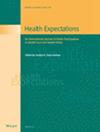Patient and Clinician Perspectives on Communication in Primary Care Centres in Qatar—A Focus Group Study
Abstract
Introduction
The Primary Health Care Corporation (PHCC) in Qatar manages 31 health centres serving a diverse population of over 1.7 million people. PHCC is fully committed to providing people-centred care. Patients are routinely asked to complete satisfaction surveys. The surveys have shown continued shortcomings in patients' perceptions of communication with staff. PHCC decided to carry out an improvement collaborative among all centres on improving communication with patients. A realist review was carried out to identify possible communication interventions that improve the outcome of patient satisfaction with communication. Most research studies in the review were carried out in Western countries where patient expectations and experiences may differ. Therefore, focus groups of patients and staff were carried out to learn how patients and staff in Qatar perceive communication in the health centres.
Methods
The purpose of the focus groups was to learn directly how patients and health centre staff experience communication with each other and if the issues experienced could potentially be addressed by the interventions identified in the evidence base. 18 focus groups were carried out, 9 each with patients and multiprofessional staff. Questions were derived from issues raised in research on patient–healthcare professional communication in primary care.
Results
Patients' main concern was how they are welcomed to a health centre, particularly their desire to be greeted with a smile and welcomed courteously. They also discussed confusion about how the health centres work and a lack of understanding of health-related information. Staff groups also raised the importance of welcoming patients; they also discussed patients' lack of understanding of healthcare subjects. Some issues were consistent with research findings; others were unique to the Qatar setting. Patients focused on their expectations to be seen quickly, whereas staff were aware of the demands on the service and difficulties in meeting patient expectations.
Conclusions
The focus groups identified key issues related to patient–healthcare professional communication in primary care centres in Qatar. These issues were used to set priorities for the improvement collaborative on patient-centred communication involving all the health centres.
Patient and Public Contribution
PHCC has created and fully implemented a Patient and Family Advisory Group (PFAG), which is a group of patients that closely works with PHCC's leadership to ensure that the patients' voice is heard and that proper collaboration is taking place between patients and PHCC at all levels of its operations (see https://www.phcc.gov.qa/patients-clients/community-engagement). The PFAG was aware of the findings of the patient satisfaction surveys and PHCC's intent to work with patients on improving communication with health centre staff. PHCC also has established a Patient Friends programme in which patients are invited to participate in different activities taking place within PHCC and at each of the health centres. PFAG members and Patient Friends were included among the patients invited to participate in the focus groups. Patients were active participants in half the focus groups. In each of the patient focus groups, the purpose was clearly explained, and patients were invited to add whatever points of discussion they wished to add in addition to the moderator's questions. Patient Friends from all health centres later attended a conference at which findings of the focus groups were openly presented as the basis for the collaborative on improving communication. The Patient Friends then participated equally with staff groups in selecting the patient-centred communication subjects for improvement via the collaborative and worked as partners with health centre teams on communication improvement projects.
Clinical Trial Registration
Not applicable.

 求助内容:
求助内容: 应助结果提醒方式:
应助结果提醒方式:


